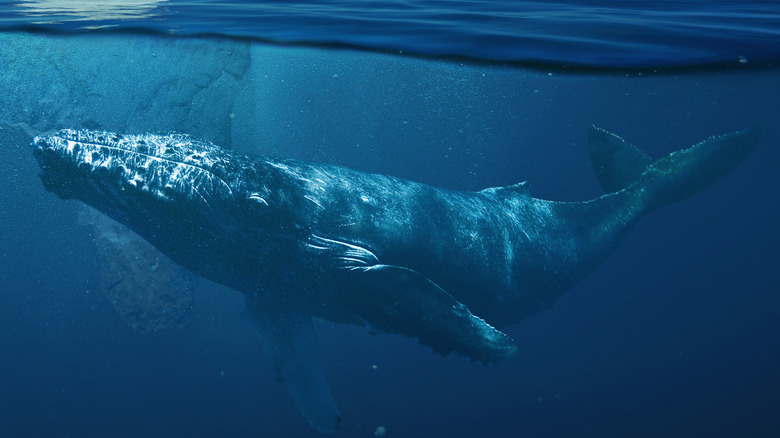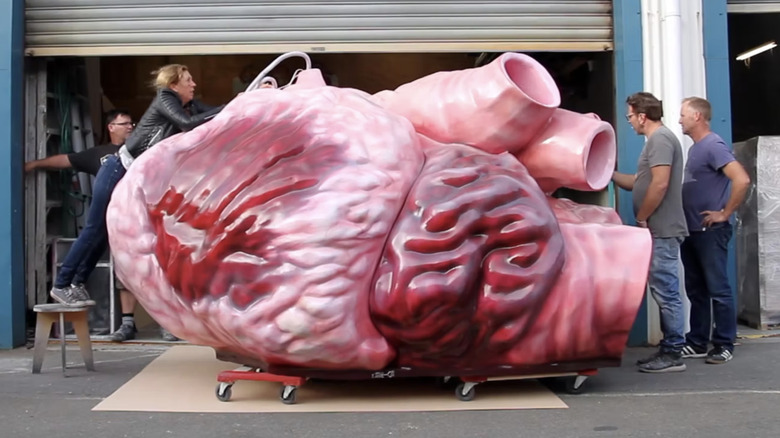A Whale's Heart Resonates In An Unexpected Way
As children, we were all fascinated with animal facts. Which one's the fastest (cheetahs, via Britannica)? Which one's the sleepiest (koalas, via Australia Koala Foundation)? Which one's the most venomous (arguably the Box Jelly fish, via National Geographic)? And which one's the largest animal in the world? It's the Antarctic blue whale (via World Wildlife Fund).
The hearts of most animals are scaled to the size of the animal. In order to supply every bit of that huge body with oxygen, the blue whale heart is also the biggest in the animal kingdom.
While the resting human heart beats around 60 to 100 times a minute (via Mayo Clinic), the heart of a blue whale beats around 25 to 37 times per minute when they're at the water's surface (via Proceedings of the National Academy of Sciences). But that's nothing. During one of its notoriously deep dives, which can go as far under the water as 1.8 miles, the heart rate of these mammals can go down to four to eight beats per minute (via the Natural History Museum of London). Blue whales can stay underwater for an average of 30 minutes, but can last up to 90 (via A-Z Animals). Scientists are now beginning to understand more about what the hearts and bodies of whales do to make them underwater eating machines.
Water aerobics for blue whales include lunges
The job of the heart is to pump blood, filled with oxygen and nutrients, around to all the cells of the body. As an animal is active, it uses up the oxygen in its blood. More activity means muscle cells need more oxygen, and heart rates increase.
Blood, just like any other liquid, is at the mercy of the laws of physics. When liquid is flowing through a wider opening, there's less resistance. So, with larger blood vessels, the hearts of whales aren't experiencing as much resistance with each pump, meaning they don't have to beat as often (via Circulation Research). Plus, a whale's heart is a huge muscle acting as a pump, and can get a lot out of fewer contractions.
Whales can be very active while diving, including one incredible behavior that raises its low heart rate. One of the many reasons sea mammals dive is to get to their food source. The blue whale is known to engage in a behavior called lunge feeding. When it spots a mouth-watering school of krill, blue whales line themselves up with their prey and lunge at speeds up to 20 miles per hour (via National Oceanic and Atmospheric Administration Fisheries). In one of nature's biggest bites, during lunge feedings, blue whales open their mouths up to 90 degrees wide (via American Scientist). During the lunge feedings, the blue whale's heart rate increases 2.5 times more than its usual four to eight underwater beats per minute. So, how does the whale get enough oxygen to its muscles during a lunge with such a low heart rate?
A whale's cells are less hungry for oxygen
Diving mammals have very low heart rates, also called bradycardia (via University of California Santa Cruz). Bradycardia is usually a problem and our bodies have reflexes to respond to it. In whales, these reflexes are shut down, allowing them more swimming time (via Physiology). The slower beating helps conserve the oxygen in their blood, allowing them to dole it out over longer lengths of time (via Proceedings of the National Academy of Sciences).
In a recent paper from Frontiers in Molecular Neuroscience, scientists looked into how cetacean (marine mammal) cells can survive without new oxygen. They compared whale cells to large land mammals, and there were some fascinating differences. First, the whales are making a lot of proteins for the mitochondria, the powerhouse of the cell, which uses oxygen to make energy (via National Human Genome Research Institute). This makes whales more efficient with the oxygen in their blood. Second, brain cells love to signal each other and this uses up a lot of energy (via Cell Metabolism). Whales don't produce as many signaling proteins, which makes the oxygen-gobbling brain a little less hungry. And third, whales have more proteins involved in the breaking down of the energy packed protein glucose (per Khan Academy) even when there's no oxygen around.
Whales are just plain better at using the oxygen they already have in the blood pumped around by those big hearts. That's why they don't need as many beats per second as the rest of us mammals.


